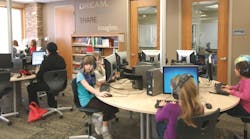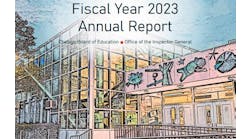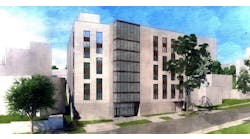While children clamor to get their hands on their parents’ cell phones or tablets, schools and universities are equally eager to have hands-on technology in their classrooms — forcing educational institutions to rethink how they design their facilities.
There is no disagreement among educators that technology is an essential part of learning today. Because of the need for an increasingly digital education, many school districts have implemented or are deep in conversation about ubiquitous, one-to-one technology in the classroom, in which every student or teacher has a device to use anytime, anywhere.
Whether you are talking about K-12 or higher education, “you can’t have an educational institution that does not acknowledge the presence of technology,” says David Jakes, CannonDesign’s educational digital design strategist. Yet as schools incorporate technology into their curriculum, they also have to “understand the shift in learning that needs to occur because of technology,” and recognize that you can’t switch to “a ubiquitous environment without a consideration of what that means to learning spaces,” he says.
For example, with wireless technology, schools may need to get rid of computer labs with desktop computers and install more outlets so that students can plug in and recharge their devices. Or, a college lecture room may need more student presentation capabilities.
“The question that emerges is how to reshape and rethink the traditional educational experience when technology is a driver,” Jakes says. “Does the library get reshaped from a traditional library to a more common lounge? If we expect students to collaborate and engage with technology, does the educational space support that?”
Essential Infrastructure
Among the first steps in incorporating technology into the classroom is addressing connection and power needs. Traditionally, schools may have constructed a computer lab so students could get online. But thanks to wireless technology, facilities instead need more bandwidth and charging stations.
“With the influx of devices, you need to ensure your network can handle it and that you have enough wireless access points and bandwidth to support the traffic and switches,” Jenks says.
For example, Chuck Rudalavage, director of higher education for EwingCole, says at one university his firm worked with, facility managers were perplexed when they arranged desks and chairs in their library in a straight line, and every morning they would find the furniture had shifted. Once the university realized that students were moving the furniture so that they could sit adjacent to power receptacles, it installed more places for students to plug in, he says.
“Five years ago there was a concern about data, today it’s really about power and if you have enough wireless access points,” Rudalavage says. Universities can take different approaches to solve this problem — by installing furniture with plug-ins, or tethering furniture close to a post with plugs or a floor box, he says.
At the K-12 level, Paul Erickson, president of ATS&R, says schools like the I.J. Holton New Intermediate School in Austin, Minn., are installing kiosks and high-top tables and stools in common spaces such as corridors, hallways and cafeterias so that four to five students can converge around a shared space, socialize and recharge their devices. On the other hand, some schools are creating a storage room with power receptacles to charge some 30 devices overnight and then roll those devices on a cart into classrooms during the school day.
Beyond basic power and wireless needs, facilities may have additional presentation or infrastructure needs to keep pace with a modern-day educational environment.
A.T. Still University’s Missouri School of Dentistry & Oral Health in Kirksville, Mo., for instance, decided it needed a simulation room with individual student monitors and recording devices to create an environment where students can evaluate instructor demonstrations and practice procedures in a way that simulates the work they will encounter when they get out of school, says Sal Bonetto, vice president at CannonDesign. SUNY Upstate Medical University also installed robotic simulation labs where nursing and doctoral students, for example, have to stop and save a robotic patient that is suffering from a heart attack, Rudalavage says.
Meanwhile, the MaST Community Charter School in Philadelphia decided that to enhance the experience when a teacher reads a book to elementary school students, it wanted to project a larger image of the book on the school library floor, so students can gather around the 4-foot-by-8-foot image and better see what the teacher is reading.
Regardless of what a school decides its technology needs are, installing more infrastructure obviously adds to upfront design costs. To temper that, technology can be phased into schools in a tiered approach, depending on space and budget constraints, Erickson says. He suggests incorporating technology at the tier 1 design stage might mean tearing down a wall between two classrooms to create a larger team-learning area. While “the tier 3 or 4 design stage might involve changing the configuration of six or seven classrooms and moving technology out of the classroom into a lot of different spaces.”
Sometimes, technology has to work around a building’s existing design. Erickson recalls in Minneapolis, his firm encountered an old high school built in the 1820s that had thick walls, which affected placement of wireless access points. “Sometimes it’s a challenge [to incorporate technology],” he admits. However, he says the key to incorporating technology is to be flexible.
In the Minneapolis school’s case, designers solved the access problem by running more exposed conduit. “There’s nothing wrong with kids seeing the guts of buildings and architectural treatments that look high-tech” if you’re doing it to “enhance new technological learning approaches in their educational environment,” he says.
Focus on Flexibility
Designers emphasize that in an age of constantly evolving technology, both K-12 schools and higher education institutions need to be careful that technological accommodations are flexible.
The lifespan of tech devices is changing rapidly, cautions Steve Gastright, education planner and architect with EwingCole. Moreover, at the college and university level, schools cannot dictate what devices students bring to school. From a technological standpoint, higher educational facilities need to address “what happens when you bring in three different devices and create the capacity to connect all those devices so students can network,” Jenks says.
Consequently, as schools incorporate technology into their facilities, there needs to be a balance between flexibility and durability. “There tends to be a desire from an architectural point of view to integrate everything [regarding technology] into architecture, such as having screens come down from ceilings, because it adds to the cleanliness and sparsity of the space,” Gastright explains. “But those things have the shortest lifespan. Aesthetically, schools usually have to make a compromise, because technological devices may have a five-year lifespan and you’re talking about implementing them into a building with a 50-year lifespan. Schools need flexibility to retrofit as technology changes.”
Gastright says schools typically address this problem with flexible, movable furniture. And in presentation areas, that may mean a school needs to live with less than HD surroundings and not try to recreate a theater environment, as long as it has a space to project images. “We think the approach where you think of everything as furniture and space is flexible serves the client well,” he says.
Centers of Collaborative Learning
In addition to creating flexible spaces, designers say schools often turn to them for help in implementing technology in a way that makes the educational process more collaborative.
The Lovett School in Atlanta, for example, assigns laptops to students so that they can “become more engaged in their own learning and expand their learning environment beyond the classroom walls.” In line with that “21st Century Learning” goal, the school also wants to thoughtfully integrate technology into the classroom to complement the traditional learning process with a “creative, flexible and agile experience” for its K-12 students, Jakes says.
The typical school desk does not provide enough room for students to work on projects as well as place a laptop. So, Jakes says the school removed the teacher’s desk in some of its classrooms, which freed up real estate in the classroom to introduce movable furniture and larger workspaces.
ATS&R’s Erikson says he has seen a similar approach in school science labs. Because students need a place to put their laptop or tablet but they “don’t want chemicals spilling on their computers,” lab station platforms are getting larger, casework and cabinets are shifting to the perimeter of the classroom, and the center of the room is often left open for instruction and demonstrations, he says.
In general, implementing technology in the classroom typically means schools need to design fluid learning spaces and “centers of engagement” to accommodate more blended learning, instead of just one-way directional classroom instruction, Erikson adds. Educators want a space that has desks or tables and chairs on movable casters so that teachers can give instruction but also provide a place for independent research and project-based collaboration, he says.
A teacher may have a smart board and a projector to give instruction, but once done, the teacher may need the flexibility to reshape the room with group tables and a monitor that a small group of students can plug into to share work. Or, there may be a need for an area with transparent, acoustically treated glass where a student can do independent research but is still under supervision.
Because classroom real estate is precious, more schools are removing a separating wall between two or more classrooms and replacing it with movable, writable walls, Erickson says. “There can still be separate rooms when more supervision is needed, but teachers can create a wide, open space when they want to encourage team participation,” he says.
Even at the college level, schools are finding that students are seeking out spaces in which they can collaborate. EwingCole’s Rudalavage says nursing students at Anne Arundel Community College in Arnold, Md., are looking for group rooms to study things like vocabulary, which previously would have been more individual study.
High Performance Outdoors
Educators need to think about incorporating technology outdoors as well as indoors, says Gastright, who focuses on school design for Department of Defense Education Activity (DoDEA) schools for military children in the U.S. and on American military bases overseas. He notes that while screen time in classrooms is beneficial and engaging, fatigue can set in.
“The downside to technology is that if kids have devices all day, they can get distracted, where they ‘screen out’ and miss what’s happening in the classroom because they zoned out and got lost in something that they’re doing on their device,” he explains. “One of the innovative ways we’ve seen the Department of Defense address this is by having more outdoor educational settings,” he says.
Many facilities will have an outdoor bio-amphitheater that provides an educational opportunity to teach students about sustainability, as well as serves as a gathering space. The U.S. Military Academy Prep School in New York, for example, created an outdoor classroom gathering adjacent to an indoor classroom. “Studies show engagement with outdoors provides relief from concentration fatigue,” Gastright says. “The outdoors is really critical to the next step of development for technology.”
When incorporating technology into an outdoor educational setting, Gastright says his firm often looks to the existing environment. If there is a woods onsite or a river nearby, his firm works with the school to determine what opportunities they would use most, he says. One school may want a feature that helps to build math skills while another may want a space that encourages teamwork. Alternatively, a school might want to embed quick-response (QR) codes around a facility so students can gather information with technology outdoors.
As long as facilities plan for these educational opportunities, then “when the weather conditions are suitable, students can move outside and do some authentic learning outdoors through hands-on activities,” Gastright says. “The key to integration is stitching spaces to the exterior that in the long-term will reap the most benefits. You don’t want to design something inside or outside the classroom that the school doesn’t really want to use and pay for.”
Whether indoors or out, technology in an educational setting has its benefits. At a small school, technology may provide online learning opportunities so students can take more AP classes and follow their passion,” Gastright notes. Technology at another school may provide opportunities for students to collaborate on multimedia projects.
Whatever the case may be, as educational facilities get more “connected,” they need to ask themselves if they have flexible digital and physical spaces for learning, and if not, how do they re-craft existing spaces?” Jenks says.
“After all, when you’re talking about a 21st century education, you have to recognize that technological devices are a fixture that will be in children’s lives for the foreseeable future, so students need to develop the skills to use the devices to gather and analyze information,” Gastright says. “Incorporating technology [into an educational facility] is just continuing to make learning relevant for kids.”


